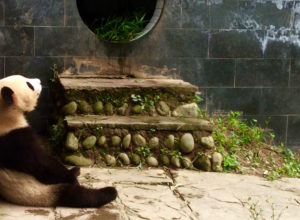As we conclude our first several weeks at Bifengxia, it’s a great time to reflect on the delightful conglomeration of exploring and learning that we’ve experienced. The three of us hit the ground running (literally and figuratively); combing the scenic expanses of the Panda base and absorbing the research protocols as quickly as possible. In the first week, we spent the majority of our time getting to know the bears and familiarizing ourselves with the vast array of their individual behaviors. We practiced the observation basics with our mentor, Nathan Wintle; and fine-tuned our detection skills for the various projects. While the Stereotypic Behavior study is extensive, and each animal has unique habits that are specific to their pen location and neighboring animals…the muscle memory that you develop from practicing with our Ethogram, goes a long way. Once we became confident with our appraisals of the behaviors, we tested our scoring values against the ones Nathan recorded for the same time slot, evaluating the same panda. Each of us had to come within 90% of identical scoring to his, in order to take off on our own with the stereotypic observations. Once we were cleared for takeoff, we divvied up the observation load and went separate ways twice a day for our one-hour A.M. and P.M. sessions.
After just a few of these sessions, it becomes apparent how unique each panda’s personality is. They exhibit different levels of interest in humans; different motivations; different food preferences and certainly, different stereotypic habits. The wide range of engagement in stereotypes is influenced by many factors and we try to account for many of these in our documentation. There are indications that wild versus captive birth can play a role in these trends. But housing dynamics and genetic predisposition must also be considered. Researching the animals’ cause and effect relationships with stereotypical behaviors, illuminates many questions about the species and shines an interesting light on potential human similarities (Eg. I bite my nails, and start humming when I’m nervous).
In addition to training for the Stereotypic Behavior study with Nathan, I was the only intern to have the pleasure of training for the Maternal Care study with Meghan Martin-Wintle during her brief visit to China in August. With only a few days for me to master the dynamics of a second project (and pass Inter-Observer Reliability at 90%) Meghan and I took advantage of every minute that we had in front of the panda mothers and their growing cubs. I learned so much from her about how to interpret the interactions between female pandas and their young. The opportunity was pretty priceless. In the wake of Meghan’s departure, I get to train my intern companions on the new study and help them achieve 90% reliability. Every step of this journey is a learning experience for us. We are having a great time tackling challenges together and growing in our scientific research capabilities.
While conducting the maternal care observations, I have discovered primarily, that panda moms are as variable in their maternal care behaviors as our stereotype-study pandas are in other behaviors. While some moms are very attentive, and seem to devote most of their energy to child care…other moms seem very relaxed about the wellbeing of their little one, and focus more time on eating and sleeping (cuddling often included). There is very little stereotypical behavior observed during the first few months of a cub’s life. Even the relaxed mamas have their hands full during this time with feeding, cleaning and admiring their newest addition. It isn’t until the infant approaches the three or four month mark, that some panda moms begin reverting to old habits. At this point, it becomes more common to see mom displaying some stereotypical behaviors while her cub is working hard to become independence.
Of all the panda moms that I’ve gotten the opportunity to observe, there is a clear standout for the gold medal: Ying Hua (瑛华)! Ying Hua is known as one of the best, most attentive mothers at Bifengxia. She is so good with her own cubs, that she is often chosen to be the foster mom to any orphaned cub in need of care. She devotedly cradles her baby in her arms and often envelops them in the warmth of her body. Even while she is eating, she prefers to have baby in one hand and bamboo in the other. She gives her infant long, loving baths and caudles them the moment they begin to cry. If Ying Hua absolutely has to depart from her cub to go to the bathroom or to drink from her water bowl, she tucks the infant away under the bamboo, to protect them from getting cold or from prying eyes.
Ying Hua has two daughters at Bifengxia: Da Bai Tu (大白图) and Dian Dian (点点). Both of these beautiful girls are fan favorites in their own right. Da Bai Tu is a healthy, young, female panda who loves her hammock and is shy around the visitors. She can often be found resting in her bedroom or, sunning in the furthest corner of her outdoor enclosure where she is afforded a bit more privacy from daily traffic. While she is a bit bashful around new people, she exudes happiness and likes a familiar face. It is obvious that Da Bai Tu had good parenting when she was young. Ying Hua’s second daughter, Dian Dian, got her name by being one of the smallest newborns on record here. At only 75 grams, little Dian Dian exploded into the world with a big personality! Her physique has grown slowly, and continues to be tiny in comparison with her peers…but Dian Dian’s spirit cannot be contained. She is a playful, curious, youngster who loves her human care givers and has a strong appetite for fun. At a very young age, she loved climbing trees and tumbling around in the grass. Today, at just over two years old, not much has changed. She enjoys human company so much, that she prefers to wait inside her den on the off chance that she gets visitors. She will excitedly climb the bars of her enclosure when she hears them coming. Many of the staff members at Bifengxia have a special soft spot for Dian Dian, and take advantage of every opportunity they get to spend time with her. She loves bamboo as much as the next panda; but unlike her mom, Ying Hua, she never turns her nose up at the offer of an apple. The insatiable little bear is sure to grow in to her attitude in no time. An import update about Dian Dian, is that she is moving! Someday, we may be lucky enough to see Dian Dian back at Bifengxia, becoming a proficient parent like her own mama…but for now, this little lady is taking off to the Beijing Zoo to win more hearts and discover a new land. We will be wishing her all the best in her new adventure, and looking forward to updates on her progress. Safe travels Dian Dian; you will be missed!
______________________________________________________________
 Thanks for the really thoughtful update- Katelin! We look forward to hearing more about your maternal care observations and how the move goes with Dian Dian. PDXWildlife is a registered 501 (c)(3) non-profit and all donations are 100% tax deductible. To learn how to help, Click HERE.
Thanks for the really thoughtful update- Katelin! We look forward to hearing more about your maternal care observations and how the move goes with Dian Dian. PDXWildlife is a registered 501 (c)(3) non-profit and all donations are 100% tax deductible. To learn how to help, Click HERE.




What an excellent report! I look forward to reading more reports by Katelin. Thank you.
Great insights – I’m interested in hearing more about Dian Dian’s move in the future! Please keep us posted! Thanks for posting!
Sincerely, JoAnn
Hi JoAnn,
The Beijing Zoo has a really good program and the pens are full of enrichment to keep the bears busy. I’m sure she will have a great transition.
Nate-
Great update, Katelin–and I continue to be jealous of your participation in the mom and cub studies–what could be better! We just saw a pair of frisky twins with their mother at Shanghai Zoo, wrestling with each other and climbing over the plexi barrier between their enclosure and the moat. I hope Dian Dian will be happy there, as it sounds as if she will be missed at BFX.
Frances